 Chimney
stacks and pots – Part 2
Chimney
stacks and pots – Part 2
Back to: Chimney Pots and Stacks – Part 1
Chimney pots
Chimney pots have been used in Britain since at least the 13th Century. They are usually made from clay or tin. Chimney pots are known as 'cans' in Scotland, and 'tuns' in south west England.
Chimney pots serve a purpose although not everyone appears to have adopted them as chimneys without pots were common in East Anglia.
Purpose of chimney pots
1. Increase the speed smoke rises by reducing the size of the outlet – warm air rises so this 'bottleneck' can create a jet-like effect.
2. This reduction in the size of the opening also reduces the entry of rain and downdrafts of air that can prevent the smoke leaving the building, and scatter hot embers from the fire.
3. Openings in the pot – like louvres, grills, pockets and horns – can promote cross-drafts at the top, which also serve to increase the flow of smoke up the chimney.
4. Changes in the roof or neighbourhood (growth or felling of trees, or other buildings being erected) can impact on the efficiency of a chimney. Chimney pots are a simple way of raising the level of the chimney (Tallboys – a type of chimney pot but also the name given to a type of wine glass, chest of drawers, and a 6-ton WWII RAF bomb – can be up to 7 feet tall).
Finishes and colours
Clay pots tend to come in three main finishes: terracotta red; terracotta buff or salt glaze (a ceramic glaze created by throwing salt into the kiln at the hottest point during firing – the sodium in the salt combines with silica in the clay to form a glassy coating of sodium silicate, which acts as a weatherproofing and extends the life of the pot). Some salt glaze pots can also be considered to be stoneware (basically any pottery fired to around 1,200 degrees centigrade). Although, strictly speaking, as stoneware is waterproof it does not need a glaze.
Terracotta (Latin for 'baked earth') generally refers to any fired clay that changes colour during the process and becomes anything from dull ochre to red.
Rarer to find are black and Staffordshire Blue finishes, although there are pots still being made with these finishes.
Problems with identifying Chimney Posts
Firstly, the sheer number of different designs. Many were one-off creations which were not catalogued. The Chimney Pot Museum – at Longport, Stoke-on-Trent – has a collection of over 2,500 pots. The National Clayware Federation's 1964 catalogue contained nearly 500 designs of chimney pots which had been in use for a century or more – at a time when domestic fires, chimneys and pots were rapidly going out of fashion.
Chimney pots have some exotic names – like Weemac and Spiral Captain, and different manufacturers may call the same design by different names – like Smoke Cure and Champion.
Even today, nearly 50-years on with coal and log fires now something of a rarity in the average home, suppliers offer over 300 different designs.
When viewing chimney pots from the ground or a distance it is not always possible to tell whether it is a single piece of elaborate design or a combination of components (like a pot with an addition of a louvre or cap, or simply two pots joined together for added height). Also the style of the base may not be visible, which also hampers identification.
Pots are flaunched (also spelt ' flanched') in place on the stack. Basically, this means the cement or mortar slopes inwards towards the top of the pot so rain drips off rather pools around the base.
Water entering cracks in the pot, which naturally occur over time with the expansion and contraction due to temperature changes, will freeze and expand during winter and eventually shatter the pot.
As a result, chimney pots that became largely redundant due to the installation of gas-fired central heating, were later thought of as a nuisance to maintain and a potential health and safety hazard. Sadly, this has led to several pots being removed or cut back to stumps (and sometimes capped).
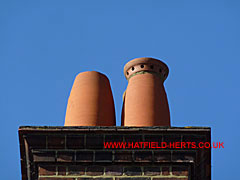
Chimney stack on Willow House with two orange clay pots clearly visible, and a bit of another behind the pot on the right. These appear to be Beehive or Moulded Roll pots (however, these tend to have a beaded rim but it might have been cut off for capping). The right pot has been capped (usually a sign that there isn't an active fireplace beneath). Pots are capped to prevent the entry of rain, snow and wind, and birds nesting on the pot. The cap appears to be a Fluevent type spigot which has a section that fits inside the pot. Saddle, Bonnet and Flouch are other types of spigot caps.
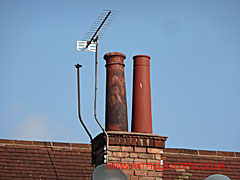
Stack with two tall pots on one of the shops in Hatfield town centre as seen from the Kennelwood House side. The left pot with its more pronounced lip resembles a design called a Roll Top. It streamlines the top of the pot aiding airflow – in effect, aerodynamics was being used long before any aircraft were invented. The other newer one could be the same or classed as a Beaded Top or even a Roll Base.
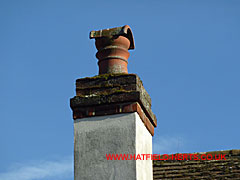
This round chimney pot on a bank in Hatfield town centre has been fitted with a hood or bonnet.

Stack on former bank building on what was Brewery Hill (now part of Salisbury Square). Simple Roll pot and two Three Ring Louvre pots with Cap. Louvres boards on top of fireplaces, which were movable through attached strings, were used as early as the 13th Century. They allow air to circulate from any direction while preventing rain entering. From a distance it is hard to tell whether these are the spigot type inserts that fit into an existing pot or purpose-built pots.
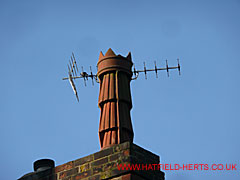
An interesting, if slightly damaged, ornamental clay pot on a roof in Fore Street. The sides are fluted in three distinct bands or rings with a circular spiked crown beaded at the top and bottom. One of the spikes in the crown is missing. This may be an example of a type of pot called a Bishop. Further back on the stack is what appears to be a round, metal flue terminal, which suggests it is capping the opening where another pot would have been.
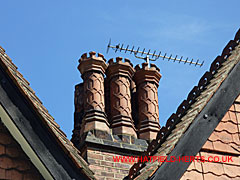
Ornamental Octagonal terracotta pots with crenellated crowns on the cottages by the viaduct entrance to Hatfield House. The crowns were almost certain made separately and then joined to the main body of the pot.
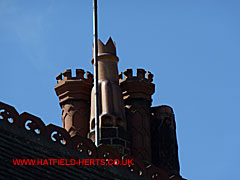
Same stack seen from the other side. In the second row, one of the Ornamental Octagonal pots is missing its crown, and one has been replaced a spiked design, thought to be a Smoke Cure or Champion pot.
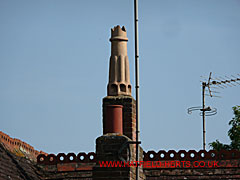
Smoke Cure or Champion pot on a roof of a house at Mill Green. Stepped below on an adjoining stack it is a simple terracotta Roll pot.
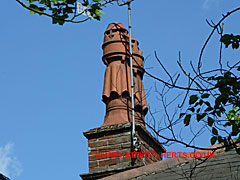
Seen from School Lane, this brick stack has two large fluted pots with spiked crowns (Smoke Cure / Bishop style). However, they appear to have had Ringed Louvre pots or spigots inserted in the crown.
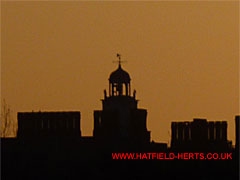
The breaking dawn silhouettes some of the rows of chimney pots on the stacks of Hatfield House. Believed to be of the Ornamental Octagonal design.
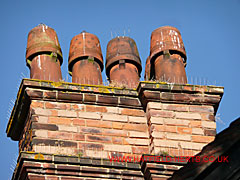
Group of Ornamental Capped pots on one of the stacks of Kennelwood House, Hatfield town centre.

Stack on one of the Rosedale Cottages with buff or stone colour (or they may have been painted white at some stage) Plain Roll Taper pots and a single terracotta Two Roll pot – probably a make-do replacement. The problem with rarer pots is that replacing them can be difficult and expensive.

This stack on Bush Hall appears to have three buff Round Pots with square bases, and a single terracotta pot. This appears to be a Three Ring Louvre with Covered Top. However, rather than a single pot it could be a combination (like a Three Ring Spigot on top of a Two Roll pot ie. a basic pot which has had a louvre attached to it)
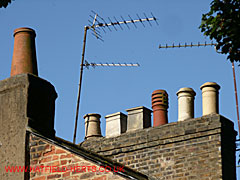
These two stacks on cottages in Church Street show how
varied chimney pots can be. The orange clay pot on the right stack is a
basic Round Pot design with a beaded top on a tapering base. However,
the adjoining stack has 6 pots featuring several different designs.
L-R: buff or stone glaze round Two Ring Pot or Cannon Head; 2 x buff or stone glaze square Plain Taper Pots; terracotta Three
Ring Louvre with Covered Top; and 2 x buff or stone glaze round Parallel
Roll pots with matching Dome Caps or they could be Cannon Head pots.
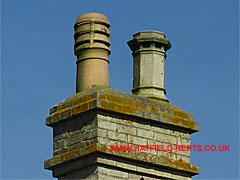
Close up of the pots on the two-pillared stack of Lemsford Cottage (described under 'Chimneys'). The buff coloured pot on the left appears to be a Three Ring Louvre (unusual due to its colour but this may be a red pot that has been painted over). While the one of the right is an Ornamental Octagonal design, which bears a resemblance to an early postbox.
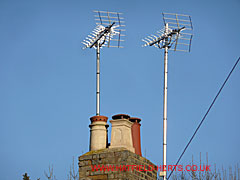
This stack off Church Street sports three capped pots. L-R: round buff Cannon Head capped with a terracotta Fluevent Spigot; buff Panelled Square pot fitted with a Dome or Cone Cap; terracotta simple Roll pot with a similar cap. The gap shows that these aren't meant to seal the chimney so are used as spark arrestors (particularly important in rural areas with crops in the field or thatched houses) and rain preventers.
Although open fires are now something of a rarity, houses are still being built with chimneys and chimney pots – even though they often don't have a fireplace or flue underneath. In these cases the stack and pot is simply a decorative feature to lend character and give the house a certain 'age'. This is common in conservation areas or where the developers want to give a property a traditional look.
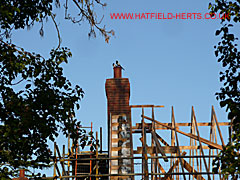
The brick stack and pot came readymade and is being installed on top of a gable wall of this house, built in 2010 in the grounds of the Old Rectory. Two magpies are using the simple Roll pot as perch.
So while chimney pots are rarer than they once were they are still being used to adorn houses and will be a part of our lives for many more years to come.
Back to: Chimney Pots and Stacks – Part 1
Back to: Hobbies and Collections